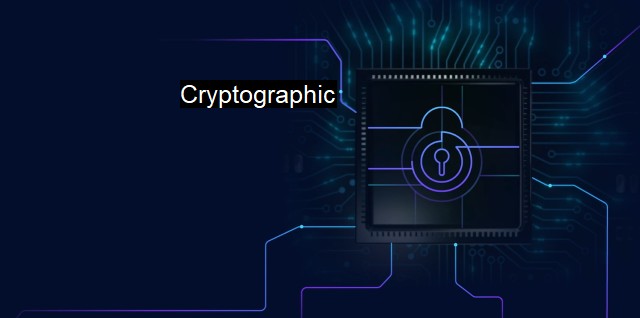What is Cryptographic?
Cybersecurity Unleashed: The Importance of Cryptographic Technology in Protecting Sensitive Data
Cryptography is a term derived from the Greek words "Kryptos," meaning hidden, and "graphene," meaning writing. In simple terms, it refers to the coding and decoding of data. Cryptography is the art and science of disguising information by transforming plain text into an encoded format via a specific algorithm, often known as cipher, making it unreadable and immensely arduous for unauthorized users to interpret. Once reaching its intended destination, the encrypted data is then decrypted, transforming it back into its original, comprehensible format.Cryptography plays an instrumental role. It serves as a formidable defense mechanism protecting digital data either stored on computer systems or transmitted across networks. The security of data is a critical area of focus given the inevitable surge in internet crime, hacking, and increasingly sophisticated security threats. As such, cryptographic methods have become a universal part of everyday online communication and transactions, serving as traffic signals and barricades on the digital highway.
Cryptography is behind several cybersecurity protocols employed to ensure the indubitable security of data. One conventional application of cryptography in cybersecurity is Secure Sockets Layer (SSL) and its successor, Transport Layer Security (TLS). These security protocols employ cryptographic principles to facilitate internet connection security, shielding server to browser communications from being infringed. Email encryption, IPsec tunnels for Virtual Private Networks (VPNs), and digitally signed certificates are other notable applications embedding cryptographic practices.
Evolving in step with advancements in the cyber world, cryptography has spawned several types of cryptographic algorithms that dictate how data is encrypted and decrypted. Among the most prevalent is symmetric-key cryptography, which assembles identical keys for encryption and decryption. Conversely, public-key cryptography utilizes different keys for both functions. Other prevalent and foolproof methods include hashing, used to verify the integrity of data, and digital signatures, ensuring authenticity and integrity of transmitted messages or data.
Therefore, besides obstructing hack attempts to retrieve sensitive data, cryptographic algorithms accomplish several other safety objectives, like data integrity, confidentiality, authentication, and non-repudiation. These objectives are essential to shape a secure and robust digital environment and ensure occasional system vulnerabilities don't turn into security disasters.
Expanding beyond cybersecurity itself, cryptography plays a pivotal role in antivirus conception and operations. Antiviruses are designed to ward off malicious software—malware, from infiltrating computer systems. By employing complex cryptographic algorithms to scrutinize digital signatures of potential malware threats, antivirus programs can swiftly pinpoint security threats and nullify them. They also shield vital system components via cryptographic barriers, preventing unauthorized alterations that could render the system susceptible to malware attacks.
For instance, some antivirus solutions use cryptographic hash functions to create a unique identifier—hash, for each block of data. When a file is downloaded or a webpage accessed, the antivirus solution will calculate the hash for the received content and compare it with a database of known malicious hashes. If a match is detected, it means the file contains malware and should be quarantined immediately.
Cryptography is integral to strengthening our technological world boundaries, combating cyber attackers' ceaseless attempts to overcome system vulnerabilities. This vital science is deeply embedded in effective cybersecurity strategies and antivirus software, assuring safe and secure digital communication. Some may argue that deciphering the concepts surrounding cryptography may be challenging. Still, no one can refute that utilizing cryptographic practices forms a formidable fortress in titanic proportions around our 'ones' and 'zeros.' By transforming and securing our binary digital language, cryptography shapeshift the future of cybersecurity and antiviruses, serving as a powerful weapon in preserving the safety of the interconnected cyber world.

Cryptographic FAQs
What is cryptographic technology?
Cryptographic technology involves the use of mathematical algorithms and protocols to secure, transmit, and verify information. It is often used in cybersecurity and antivirus software to protect sensitive data and prevent unauthorized access.What are some common cryptographic techniques used in cybersecurity?
Some common cryptographic techniques used in cybersecurity include symmetric-key encryption, asymmetric-key encryption, hashing, digital signatures, and secure communication protocols like SSL and TLS. These techniques help ensure the confidentiality, integrity, and authenticity of data being transmitted or stored.How does cryptographic technology help protect against cyber attacks?
Cryptographic technology helps protect against cyber attacks by making it difficult for hackers to access or decipher sensitive data. By encrypting data in transit or at rest, it becomes unreadable and therefore useless to anyone who does not have the key to unlock it. Cryptographic techniques like digital signatures also help verify the authenticity and integrity of information.What are the drawbacks of depending solely on cryptographic technology for cybersecurity?
While cryptographic technology is an important tool in cybersecurity, it is not foolproof. Hackers can still find ways to exploit vulnerabilities in software or hardware, or use malware to steal keys or intercept data. Additionally, improper implementation or management of cryptographic systems can lead to security flaws or weaken their effectiveness. It is important to use a multi-layered approach to cybersecurity that includes other measures like access controls, threat detection, and user education.Related Topics
Encryption Digital signatures Public key infrastructure (PKI) Malware analysis Digital forensics
| | A | | | B | | | C | | | D | | | E | | | F | | | G | | | H | | | I | | | J | | | K | | | L | | | M | |
| | N | | | O | | | P | | | Q | | | R | | | S | | | T | | | U | | | V | | | W | | | X | | | Y | | | Z | |
| | 1 | | | 2 | | | 3 | | | 4 | | | 7 | | | 8 | | |||||||